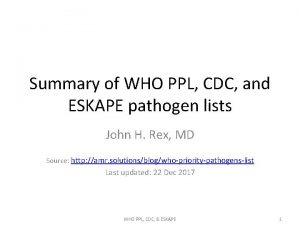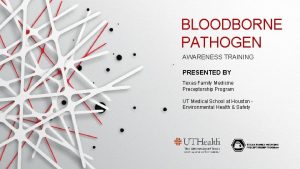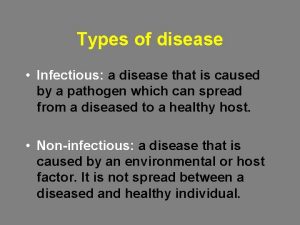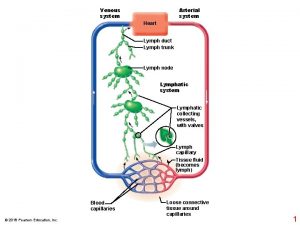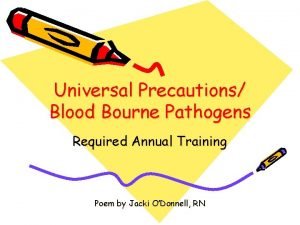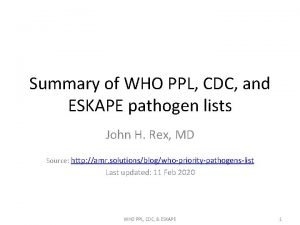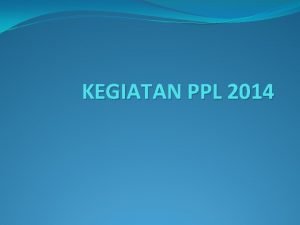Summary of WHO PPL CDC and ESKAPE pathogen





- Slides: 5

Summary of WHO PPL, CDC, and ESKAPE pathogen lists John H. Rex, MD Source: http: //amr. solutions/blog/who-priority-pathogens-list Last updated: 22 Dec 2017 WHO PPL, CDC, & ESKAPE 1

Bacteria (WHO category) WHO (2017) CDC (2013) ESKAPE (2008 -9) Acinetobacter baumannii, carbapenem-R Critical Serious (MDR) Yes Pseudomonas aeruginosa, carbapenem-R Critical Serious (MDR) Yes Enterobacteriaceae, carbapenem-R, 3 rd-gen ceph-R (ESBL+) Critical Urgent (carbapenem-R) Serious (ESBL+) Yes Enterococcus faecium, vancomycin-R High Serious (VRE) Yes Staphylococcus aureus, methicillin-R, vancomycin-I/R High Serious (MRSA) Concerning (VRSA) Yes Helicobacter pylori, clarithromycin-R High Campylobacter spp. , fluoroquinolone-R High Serious (drug-R) Salmonellae spp. , fluoroquinolone-R High Serious (drug-R) Neisseria gonorrhoeae, 3 rd-gen ceph-R, fluoroquinolone-R High Urgent (drug-R) Streptococcus pneumoniae, penicillin-NS Medium Serious (drug-R) Haemophilus influenzae, ampicillin-R Medium Shigella spp. , fluoroquinolone-R Medium Serious Clostridium difficile Urgent Candida spp. fluconazole-R Serious (Flu-R) M. tuberculosis Serious (drug-R) Group A Streptococcus Group B Streptococcus Concerning (erythro-R) WHO PPL, CDC, & ESKAPE Concerning (clinda-R) 2

Sources & References • WHO 2017 PPL (aka, Priority Bacterial Pathogens List) – Downloaded 27 Feb 2017 from http: //www. who. int/medicines/publications/WHO-PPLShort_Summary_25 Feb-ET_NM_WHO. pdf – See also Tacconelli et al. , Lancet ID, Dec 2017: http: //www. thelancet. com/journals/laninf/article/PIIS 1473 -3099(17)307533/fulltext • CDC 2013 Threat List – Downloaded 28 Feb 2017 from https: //www. cdc. gov/drugresistance/pdf/arthreats-2013 -508. pdf • ESKAPE – Rice LB. Federal funding for the study of antimicrobial resistance in nosocomial pathogens: no ESKAPE. J Infect Dis. 2008; 197(8): 1079 -81. – Boucher HW et al. Bad Bugs, No Drugs: No ESKAPE! An Update from the Infectious Diseases Society of America. Clinical Infectious Diseases. 2009; 48(1): 1 -12. WHO PPL, CDC, & ESKAPE 3

Background: First vs. Best Core messages from this analysis of the 26 discrete classes discovered to date: • Of these, 12 classes have one drug whereas one class (beta-lactams) has 63 drugs. • When more than one in a class, the span from first to next (2 nd in class) ranges from a few years to decades. • Time from first to last is usually decades. Summary • Singletons and multi-drug classes occur at similar rates • First-in-class is not necessarily best Decoding of the more obscure names Macrocycle = Fidaxomycin; Ansamycin = Rifaximin; Pseudomonic acid = Mupirocin (topical); Fusafungin = fusafungine; Peptides = Gramicidin S Data source: https: //en. wikipedia. org/wiki/Timeline_of_antibiotics ). WHO PPL, CDC, & ESKAPE 4

Just the timeline graphic WHO PPL, CDC, & ESKAPE 5
